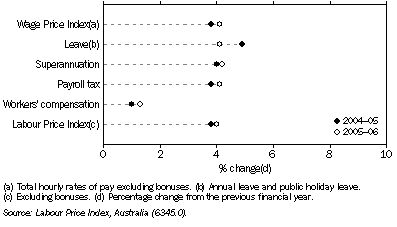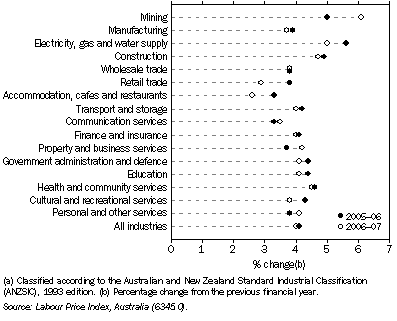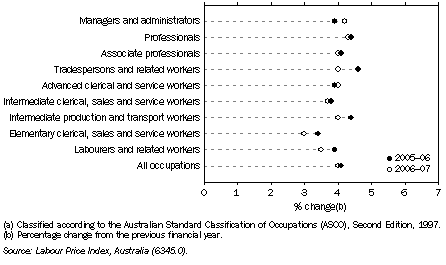LABOUR PRICE INDEX (LPI)
The LPI measures changes in the price of labour services resulting from market forces. The LPI is unaffected by changes in the quality or quantity of work performed, that is, it is unaffected by changes in the composition of the labour force, hours worked, or changes in characteristics of employees (e.g. work performance). The LPI is produced annually on a financial year basis and consists of two components: a wage price index (WPI), published quarterly; and non-wage price index, which is available for each financial year.
WPIs are compiled using information collected from a representative sample of employee jobs within a sample of employing organisations. The ABS constructs four WPIs on a quarterly basis: ordinary time hourly rates of pay excluding bonuses; ordinary time hourly rates of pay including bonuses; total hourly rates of pay excluding bonuses; and total hourly rates of pay including bonuses. Four non-wage indexes are constructed on a financial year basis: annual and public holiday leave; superannuation; payroll tax; and workers' compensation. From these wage and non-wage components, two LPIs are constructed, also on a financial year basis, one including bonuses and one excluding bonuses. Only those indexes which exclude bonuses are pure price indexes because bonuses tend to reflect changes in the quantity and quality of work performed.
Graph 29.10 shows percentage changes from the previous financial year for several LPI series. The WPI (total hourly rates of pay excluding bonuses) and the LPI (excluding bonuses) for 2005-06, show similar rates of change from the previous financial year. The superannuation index showed the highest rate of change from the previous financial year for 2005-06. Workers' compensation increased at a much lower rate than the other non-wage costs.
29.10 Wage, non-wage and labour price indexes

As shown in table 29.11, increases from the previous financial year for total hourly rates of pay excluding bonuses varied across states and territories. For Australia, the change from 2005-06 to 2006-07 was 4.0%. For the states and territories, the highest financial year growth was recorded by Western Australia (4.7%) and the lowest by Victoria (3.6%).
29.11 TOTAL HOURLY RATES OF PAY EXCLUDING BONUSES, All sectors |
|  |
 | New South Wales | Victoria | Queensland | South Australia | Western Australia | Tasmania | Northern Territory | Australian Capital Territory | Australia |  |
Index number(a) |  |
|  |
| 2002-03 | 96.3 | 96.9 | 96.5 | 96.3 | 96.9 | 96.8 | 96.8 | 95.9 | 96.5 |  |
| 2003-04 | 100.0 | 100.0 | 100.0 | 100.0 | 100.0 | 100.0 | 100.0 | 100.0 | 100.0 |  |
| 2004-05 | 103.6 | 103.9 | 103.8 | 103.5 | 104.3 | 104.1 | 103.7 | 104.3 | 103.8 |  |
| 2005-06 | 107.8 | 107.9 | 108.4 | 107.4 | 109.0 | 108.4 | 108.2 | 108.6 | 108.1 |  |
| 2006-07 | 111.9 | 111.8 | 113.3 | 111.6 | 114.1 | 113.1 | 112.4 | 113.1 | 112.4 |  |
Change from previous year |  |
|  |
| 2002-03 | 3.5 | 3.6 | 3.1 | 3.9 | 3.6 | 3.3 | 3.0 | 3.3 | 3.4 |  |
| 2003-04 | 3.8 | 3.2 | 3.6 | 3.8 | 3.2 | 3.3 | 3.3 | 4.3 | 3.6 |  |
| 2004-05 | 3.6 | 3.9 | 3.8 | 3.5 | 4.3 | 4.1 | 3.7 | 4.3 | 3.8 |  |
| 2005-06 | 4.1 | 3.8 | 4.4 | 3.8 | 4.5 | 4.1 | 4.3 | 4.1 | 4.1 |  |
| 2006-07 | 3.8 | 3.6 | 4.5 | 3.9 | 4.7 | 4.3 | 3.9 | 4.1 | 4.0 |  |
|  |
| (a) Reference base year is 2003-04 = 100.0. |
| Source: Labour Price Index, Australia (6345.0). |
Financial year increases in the total hourly rates of pay excluding bonuses, by industry, are shown in graph 29.12. Changes from 2005-06 to 2006-07 ranged from 2.6% for the Accommodation, cafes and restaurants industry, to 6.1% for the Mining industry.
29.12 Total hourly rates of pay excluding bonuses, by industry(a)

29.13 Total hourly rates of pay excluding bonuses, by occupation(a)

Graph 29.13 compares the annual rates of increase in the total hourly rates of pay excluding bonuses across all major occupation groups for 2005-06 and 2006-07. Professionals (4.3%) recorded the highest growth from the previous financial year, while Elementary clerical, sales and service workers recorded the lowest financial year growth (3.0%).
 Print Page
Print Page